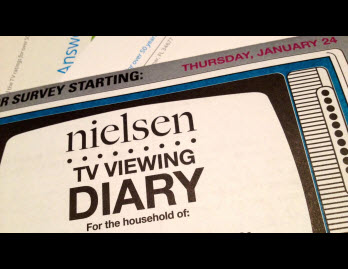OTT VOD Measurement No More Fallible Than Nielsen's TV Diary

I was maybe 7 when we became a Nielsen family. My mother wanted to throw the diary away, but I wouldn’t let her because Nielsen had sent it with a dollar.
“If we don’t do it, Momma,” I said, “we’ll have to give the dollar back.” So the diary became my project, and for the month of July I monitored my family’s television movements on a mission.
It was only at the end of the month when my mother looked over my work that I learned I’d filled the entire thing out wrong.
There was one column for the TV being on, you see, and another column for the TV being off. And the entire month, I had marked off when the tv was on, and vice-a-versa. Nielsen had paid me a dollar, I had worked hard to earn that dollar and I had let them down. “Keep the dollar,” Momma said. “They’ll figure it out.”
More than 30 years later, I still think about that Nielsen diary. How accurate was the reporting of a 7-year-old anyway?
In addition to the already disclosed on/off atrocity, I’d misspelled show names and made other mistakes. Why, I’d said “Magnum PI” was on Channel 4! I’d also marked myself as watching programs when I was really watching a family member watch the program. No one else would record their time, so if my brother watched “Voltron,” it meant I watched “Voltron” -- if only so I could write down what times he watched. That meant Nielsen measured two data points when by rights there only should have been one and — as I was older and a different gender than my brother — that the viewer demographics were polluted too.
Then there was that whole “television is on but no one is paying attention” column. What about that? Was it a trick question? Of course I was paying attention. Why, they paid me a dollar! Did Nielsen want my 7-year-old self to reveal I was slacking on the job? So if someone else left the TV on, I stayed in the living room watching it -- if for no other reason than to record that no one else was watching. Why, what if I left the living room too, then someone came back and their viewing wasn’t recorded?
Looking back, I have no other memories from that summer besides the Nielsen diary. It’s a wonder I didn’t grow blind or obese.
Fast-forward to this summer, when I spoke at the OTT Executive Summit in New York. In the session after mine, “Real-Life OTT Content Case Studies: Selecting an Audience, Producing Content, Launching Across Platforms, Monetizing and Measurement,” a panelist said the difficulty with video-on-demand (VOD) is there’s no real way to measure who’s watching. This, other panelists agreed, was an area where VOD was yet to rival traditional, broadcast television. Apparently, the fallibility of OTT VOD data compared to broadcast is a common industry perception.
To Nielsen’s credit, viewership in major markets is recorded on a box now. But, according to the company website, more than one million paper diaries still get mailed out every year (source: ).
While Nielsen still apparently relies on the errant 7-year-old, OTT VOD uses slightly more scientific ways to tell who’s watching how much — one might even call it technology. Any website, if designed correctly, is perfectly capable of telling how you found the page, your IP address, your location, whether you’ve been on the site before, what browser you’re on, which version of that browser it is, what kind of computer you own and more — with no additional effort. Let the site drop a cookie, and it’ll know how much total time you spend online, which websites you visited next, which font you use when you email your mother. And all you have to do is click.
Granted, there are advantages to the traditional diary system that neither VOD nor Nielsen’s box can measure. For example, a website cookie cannot (yet) tell you if someone’s watching a video with me. It also can’t tell you if my mom borrowed my computer to check out HGTV.com. So, yes, it’s fallible. But the industry perception of OTT VOD viewership data being less accurate than that of broadcast TV is, well, the most inaccurate thing of all.
But then again, what do I know? After all, I just got paid a dollar.
Terena Bell is cofounder and CEO of TVRunway.
Multichannel Newsletter
The smarter way to stay on top of the multichannel video marketplace. Sign up below.
